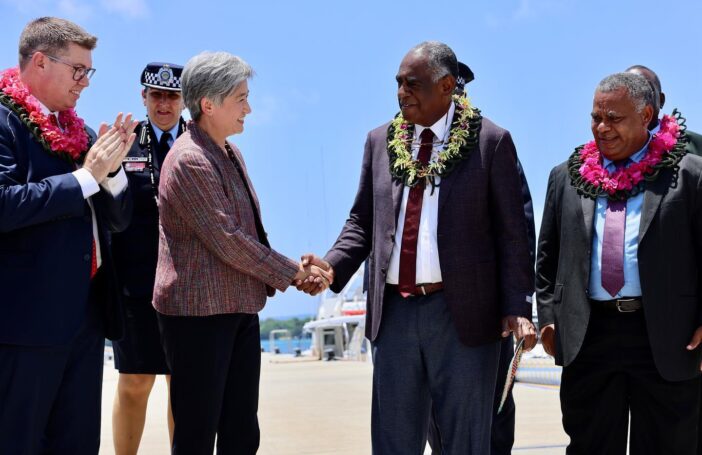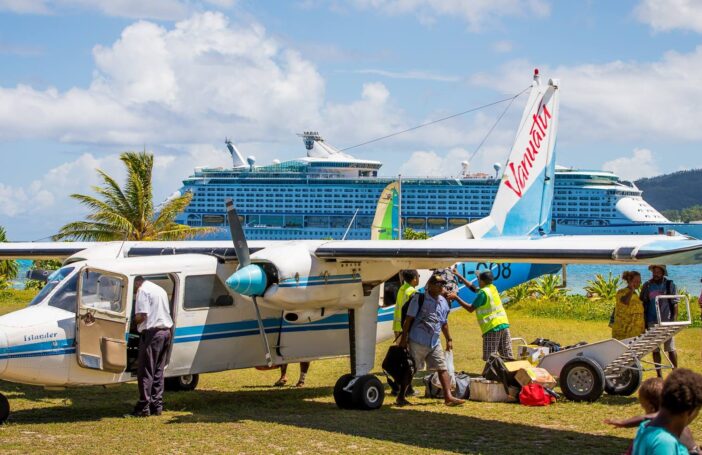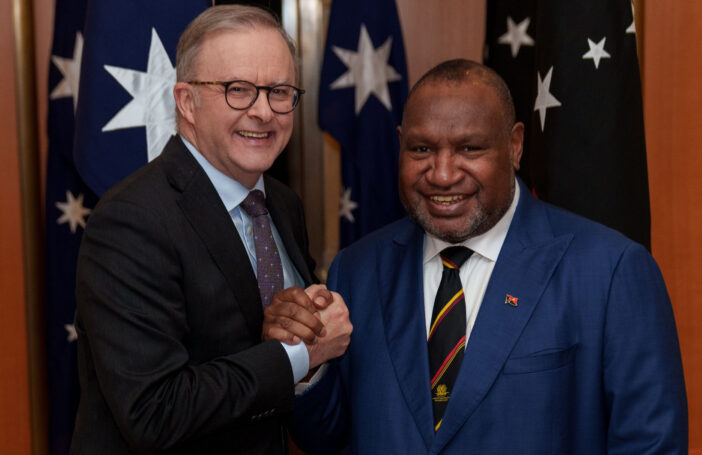In April of this year I criticised AusAID for the fact that “Despite a strategy committing it to work much more with the private sector, [it] has done little more in recent years than talk to business.”
Last month, AusAID announced it had signed an agreement with cruise company Carnival to boost tourism in the Pacific.
The MoU is the first between AusAID and a private company, according to the Australia Network.
The Prime Minister of Vanuatu, Moana Carcasses, attended the signing of the agreement and said he thought it would help the Vanuatu economy become less reliant on aid. Carnival also contributed a post to AusAID’s Engage blog on its enthusiasm about the arrangement.
As part of the agreement, Carnival said it will aim to recruit more staff from Vanuatu and run courses to develop cruise-related businesses, such as hospitality, as well as improving infrastructure for visitors. It will later expand these opportunities to Papua New Guinea.
Is this agreement with Carnival a step forward? Taken at face value, perhaps, but I’m sceptical. For a start, no dollars have been attached to the agreement. In response to our queries on the details of the arrangement, an AusAID spokesperson confirmed that a financial commitment had not yet been made under the MoU. The AusAID email to us said:
“Rather we are looking at how our programs can support Carnival Australia to improve the incomes of communities and businesses at the destinations they currently visit.”
“Our collaboration will focus on programs in technical vocational education, tourism and hospitality training, infrastructure, health and business development. The focus of the collaboration will initially be on Vanuatu, where Carnival brings many thousands of tourists each year, followed by Papua New Guinea.”
More fundamentally, is a bilateral, deal-by-deal approach the right way to deliver greater engagement with the private sector? I doubt it. AusAID is a very busy organization. It has many demands on its staff, and many partners: not only partner governments, but NGOs, and multilaterals. It also has to feed the briefing beast. It has had rapid staff growth in the past, but this will not continue. AusAID cannot afford to enter into one-on-one, bilateral arrangements with private sector companies. It doesn’t have the time and resources. It doesn’t have the expertise.
The other argument for avoiding bilateral deals is that they are non-competitive. It is always harder to demonstrate value for money when there is no competition. And they leave one open to accusations, however unjustified, of favouritism.
That’s why in the Independent Review of Aid Effectiveness we called for a facility to engage with businesses (p. 229). It is why we called for a greater use of challenge funds (p. 154) which match private sector funding on the basis of a competition between proposals. Funds and facilities enable outsourcing of project preparation and assessment, and they provide a better justification for value-for-money decisions.
AusAID ran a pilot Enterprise Challenge Fund (ECF) starting in 2007. It has been fully committed for several years, and in fact is due to close this year once all funds are disbursed. Interestingly, Carnival was successful in its submission to the ECF, and completed projects to improve jetty landings, build sanitary facilities and provide fresh water supplies on three islands in Vanuatu, resulting in a boost in the number of cruise ship visits.
Six years on from the pilot’s commencement, the Government is still yet to indicate any interest in a follow-up to the ECF, let alone make a decision on whether it will be scaled-up, or replaced by an alternative intervention, or abandoned altogether. That is the decision we need. Announcing a bilateral deal with a single private-sector company is at best a poor substitute, and at worst a step backward.
Stephen Howes is the Director of the Development Policy Centre. The Centre is currently running a working group on enterprise challenge funds to examine their performance to date and help us develop recommendations on how Australia and other donors can best use these mechanisms. See this post by Robin Davies, who is chairing the working group.






SBS Dateline has produced an item (I have not seen it) which poses some awkward questions about Carnival’s engagement with the the people of Wala island plus one of the (Vanuatu) weekend papers carried concerns as voiced by some other participants in the tourism industry about alleged “bully boy” tactics on the part of Carnival/P&O. This link is to some information about the Dateline item.
I have seen the documentary and it is a little bit confused. The problem on Wala is that the cruise ships did a deal with a landowner – but not the ones complaining in the documentary. Secondly, the Government does not get anything from this – contrary to the assertions from the documentary makers. The Government makes some money from fees at Port Vila Port and other charges but it does not amount to very much. In the old days (before the current management of SSS) they also almost never paid – however – that was not the fault of Carnival but their intermediary in Vanuatu. Since SSS got new owners things improved markedly.
So the documentary could have done with a proper fact check and historical timeline.
The challenges of this industry today are more to do with the externalities presented by Joseph’s team and ironically this is something that AusAID could help with and there was progress when the new wharfs were built under the ECF.
If we look at the tourism industry in (say) Asia and see how it currently works in terms of operators working in a more cooperative fashion with locals only Carnival comes close. The rest of the industry pretty much works against any sort of local development and this is what worries me about this documentary and also Stephens blog. It is not to say there is nothing wrong but in my opinion – by far the bigger problem – is the way the non cruise industry works in Vanuatu.
This reminds me of working in Finance – by taking on challenges and admitting things are wrong and trying to fix them you become the target. External observers then end up creating a perverse environment for policy makers because you end up overly criticising the very people that are willing to change things.
This is a really interesting discussion and one that we at Monash University have engaged with quite heavily. Both Tess and Nik were at a symposium on tourism and sustainable livelihoods we conducted in Port Vila in July 2012. There is no question that if islanders are to be in a better position to participate more profitably in tourism (and cruise tourism specifically) a public-private-community sector model may well be the best way to go. Whether tourism in general has had a net-positive impact on the ground is contentious and largely unsubstantiated owing to a lack of consistent, reliable data (notwithstanding the one-off and ad hoc approaches over the years). Leaving it up to the private sector largely to enable tourism to be a vehicle for development and poverty alleviation is fraught.
One of the biggest issues related to this discussion is that despite the fact we know very little about tourism’s overall impact (economic and non-economic impacts), there has always been, and continues to be a great deal of enthusiasm from all quarters to promote its merits. Recently, NZAID in particular have thrown their support behind the sector. There is no question that on face-value, tourism is critical to Vanuatu’s economy. However, whether it is of benefit holistically (in an economic and equally non-economic sense) is another thing. I join the line of sceptics and remain unconvinced that ni-Vanuatus have reaped an optimum return from tourism – I have been examining this issue quite closely for several years now. Growing visitor numbers and tourist expenditure does not equate to stronger development impacts on the ground.
Having said that, Vanuatu is no different to the long line of developing countries that court the tourist dollar with little cognisance of what the overall “cost” is. As my good friend and former Director of the Vanuatu Cultural Centre Kirk Huffman says – “tourism for tourism’s sake” should not prevail. In my research, I have advocated that a more deliberate, informed policy-oriented approach to tourism expansion is needed – not more ad-hoc, piecemeal attempts. Throwing money at tourism initiatives without reconciling some of the critical knowledge gaps, underpinning issues and seemingly intractable constraints first, is poor development practice. Having said that, I remain open-minded to the possibilities.
Thanks for this contribution Joseph which I think is valid on a number of levels. One of the things that was crystallised for me during the symposium you convened last year was the importance of good public policy around spreading the development impacts of tourism-derived revenues. It has a fair amount in common with resource extraction. Not everywhere has gold deposits and not everywhere has what attracts tourists so there is a pressing need for government to be able to demonstrate how the economic benefits of exploitation of the resource are being disbursed across the population as a whole.This aspect of the tourism/development nexus is largely overlooked I feel but it is really important especially if we are going to see an increase in numbers from the high volume/low (individual) spend segment.
A couple of points.
Carnival is basically the only operator in the cruise ship market in the sub-region. There are a couple of big round-the-worlders but if folk want to develop this industry along sensible lines then you have to work with Carnival. This industry in terms of growth and impact dwarfs air passengers.
Secondly, there was some fabulous work done by Monash Uni on the positive and negative impacts of tourism – folk should look at that for a balanced view of the tourism industry in the region. By and large the cruise ships tend to be better in a development sense and in a spending sense than the air passengers.
But – I think the key point in the article (for me anyway) was not that AusAID may have erred in terms of working with Carnival – but perhaps they erred in not giving the ECF program a chance to prove itself. As a deep sceptic of the ECF program I was surprised by how well the first attempt worked – this is posibly a better model of engaging the private sector.
Nevertheless, it might be good to see how this relationship between AusAID and Carnival develops before coming to a firm conclusion.
Thanks Michael for your comment.
It would seem to me that there are two ways to look at the Carnival Agreement. One is that it is a backward step because of its bilateral nature. The other is that it is nevertheless a step forward along the private sector engagement road. If the latter is correct, then it is a modest step since there is no agreement in place involving a financial commitment. We thought that was worth highlighting. I allow for both possibilities in the concluding sentence of the post, but the heading indicates that I come down on the side of it being a backward step for the reasons given in the body of the post.
I don’t think it’s fair to say I’m inconsistent. In that Canberra Times article you mention, Michael, I talk about the ECF in that same paragraph you quote from saying that “It, or something like it, would be a good candidate for adoption…” I’m all for private sector engagement, but I’m sure you’d agree that how you go about it is also important.
Stephen – Interesting post. I wonder about the balance and consistency of your remarks both in the article and over time.
In your Canberra Times article of 2 April 2013, you criticise AusAID – “Despite a strategy committing it to work much more with the private sector, AusAID has done little more in recent years than talk to business.” Yet in response to a judicious next step, an MOU with a major corporate in the region, your criticism increases, rather than abates.
Then you criticise the agreement because “no dollars have been attached”. Yet in the following paragraph you criticise the bilateral approach. How much more strident would your criticism have been in this para if there were dollars attached?
I think a healthy degree of scepticism is more than warranted. Other questions that arise in this regard are: which employment laws govern those ni-Vanuatu people who are employed by Carnival – are they covered by the Vanuatu labour laws or something else? Also, Carnival predominantly employs ni-Vanuatu people in ‘hospitality’ areas creating a demand for graduates from the APTC campus here in Port Vila which is funded through AusAID – whilst there is a certain synchronicity here it is not clear what Carnival is contributing and again there is no dollar amount attached. I have written previously that in small Pacific island economies the private sector with which AusAID needs to engage (whether by way of challenge funding or otherwise) is the private sector that is there already not the bit of it that operates on a SISO (sail in sail out) basis. An agreement of this type satisfies a need to work ‘to scale’ and reduces the number of reporting lines I guess but not much more. I look forward to having my scepticism disproved!